Hi everyone. I hope you are still in the middle of your break and are catching up on your favorite shows and spending time with your family. Or just sleeping. Our sector needs it, and you deserve it, you sexy smart hardworking nonprofiteer you. I have been off for a week, and it’s given me a lot of time to have profound and life-changing thoughts. Thoughts like “I should probably clean my fridge. I think the molds are starting to evolve into advanced civilizations.”
Anyway, one of the thoughts is, “Dude, I need to have a better note-taking system!” (Warning: This is probably not going to be the most exciting NWB blog post. Here, make yourself a nonprofit cocktail while you read this.)
We have so many meetings. Some of us have 10 to 20 a week. And every single ones results in “action items,” stuff we have to follow up on. I’ve noticed that very organized people have pads of papers with them constantly, and they draw little check boxes next to action items. Then they check them off as they complete the actions. It’s a great system, and I’ve been doing that for years. But our work is so complicated that the squares do not capture the complexity and nuances we face. What if it’s not an action we’re responsible for, but someone else is? And how do we prioritize our actions when there are so many and they’re all marked by squares?!!!!
So here, with the free time I’ve had, I came up with a system that I hope will help us busy nonprofit unicorns be more efficient with our limited time in 2015. Please try it out and provide feedback and suggestions:
The Nonprofit With Balls Note-Taking System
Materials: Sturdy notebook, and writing utensil. Or tablet and stylus. Do not use your phone. It’s hard to draw the symbols below on a phone. And more importantly, no matter what the circumstance is, you will probably look like a jerk and incur the hatred of your colleagues while typing on your phone.
Headings: Put the date at the top, followed by whom you’re meeting with or for what purpose.
Symbols to use:
All right, here’s a list of checkboxes, based on the most common follow-up items in our field. I know, there’s a lot of them to memorize. But once you get the hang of it, it’ll be so awesome, trust me! This list is by no means comprehensive. And feel free to change things around or make up your own symbols. Just make them hollow so you can check them off.
 Square : This is the standard “Stuff I need to do.” Use this often. It is your note-taking bread and butter. Example: “Email board secretary about bylaw revisions.”
Square : This is the standard “Stuff I need to do.” Use this often. It is your note-taking bread and butter. Example: “Email board secretary about bylaw revisions.”
 Circle: A colleague in the field you need to connect to, someone who can help you advance your work. This may be someone you know, or have not met yet. Example: “Invite ED of Blah-Blah org to coffee.”
Circle: A colleague in the field you need to connect to, someone who can help you advance your work. This may be someone you know, or have not met yet. Example: “Invite ED of Blah-Blah org to coffee.”
 Diamond: Something that’s related to funding, such as grants or corporate sponsors or individual donors. Example: “Submit LOI to Gates” or “Send handwritten thank-you note to Edna for 5K gift!”
Diamond: Something that’s related to funding, such as grants or corporate sponsors or individual donors. Example: “Submit LOI to Gates” or “Send handwritten thank-you note to Edna for 5K gift!”
 Star: Something that is very important and could jeopardize your org if you don’t do it in time. Grant reports, tax filings, etc. Example: “Renew charitable solicitation license!”
Star: Something that is very important and could jeopardize your org if you don’t do it in time. Grant reports, tax filings, etc. Example: “Renew charitable solicitation license!”
 Heart: Something related to a client. Example: “Check in on Abby and her mentor.”
Heart: Something related to a client. Example: “Check in on Abby and her mentor.”
 Triangle: Something someone else has agreed to do. Example: “Fred get snacks for retreat.” Very helpful especially if you’re supervising people or are in charge of making sure committee members do what they say they’ll do.
Triangle: Something someone else has agreed to do. Example: “Fred get snacks for retreat.” Very helpful especially if you’re supervising people or are in charge of making sure committee members do what they say they’ll do.
 Lightning Bolt: A brilliant idea you’ve had that you need to follow up on. Example: “NWB blog topic: Dating in nonprofit sector.”
Lightning Bolt: A brilliant idea you’ve had that you need to follow up on. Example: “NWB blog topic: Dating in nonprofit sector.”
Layering symbols:
Once you get a hang of the seven basic symbols, you can start layering them to quickly capture the intricacies of our work. The symbol on the outside determines who is usually responsible for the action being completed. Here are just a few combos:
 Double symbols: A symbol surrounded by a second layer indicates that this is ridiculously important and you need to take care of it right away. Example “ABC Foundation LOI due on 12/31!” (Complete double diamonds before going to bed!)
Double symbols: A symbol surrounded by a second layer indicates that this is ridiculously important and you need to take care of it right away. Example “ABC Foundation LOI due on 12/31!” (Complete double diamonds before going to bed!)
 Circle within a triangle: Someone will connect you with someone else. Example: “Bob–>Mary,” which is shorthand indicating that Bob will connect you to Mary.
Circle within a triangle: Someone will connect you with someone else. Example: “Bob–>Mary,” which is shorthand indicating that Bob will connect you to Mary.
 Diamond within a triangle: Someone will connect you to a funder, individual donor, or do something related to funding. Example: “Bob –>David, program officer of So-and-So Family Foundation.”
Diamond within a triangle: Someone will connect you to a funder, individual donor, or do something related to funding. Example: “Bob –>David, program officer of So-and-So Family Foundation.”
 Heart within a star: Something ridiculously important, made more important because it may seriously affect a client. Example: “Call Abby’s parents re: permission slip/medical info for camping trip.”
Heart within a star: Something ridiculously important, made more important because it may seriously affect a client. Example: “Call Abby’s parents re: permission slip/medical info for camping trip.”
 Triangle within a square: Something someone promised to do, but you know they’re probably not going to do it, and you’ll end up doing it anyway, so you might as well accept it. Optional: I also like to draw furrowed eyebrows and clenched teeth as part of the symbol.
Triangle within a square: Something someone promised to do, but you know they’re probably not going to do it, and you’ll end up doing it anyway, so you might as well accept it. Optional: I also like to draw furrowed eyebrows and clenched teeth as part of the symbol.
Advanced Symbols:
These symbols are specifically relevant to the nonprofit sector, since they occur so often. They are harder to draw. But totally worth it. Especially if you’re taking notes during retreats.
![]() Hummus: Anything related to hummus. Example: “Get hummus for reception.”
Hummus: Anything related to hummus. Example: “Get hummus for reception.”
![]() Crappy chair: Anything related to crappy nonprofit furniture. Example: “Get desk from Bobby Joe’s Used Furniture Barn for new VISTA member.”
Crappy chair: Anything related to crappy nonprofit furniture. Example: “Get desk from Bobby Joe’s Used Furniture Barn for new VISTA member.”
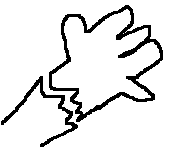 Carpal Tunnel wrist: Anything related to Carpal Tunnel syndrome. Example: “Order carpal tunnel brace for Communications Dir.”
Carpal Tunnel wrist: Anything related to Carpal Tunnel syndrome. Example: “Order carpal tunnel brace for Communications Dir.”
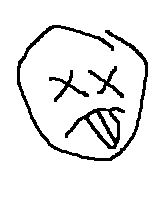 Passed-Out face: Anything related to special events. Example: “Send Doodle about first annual dinner planning committee meeting.”
Passed-Out face: Anything related to special events. Example: “Send Doodle about first annual dinner planning committee meeting.”
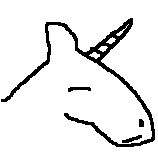 Exhausted unicorn: Anything related to team dynamics: Example: “Set up mediation session between board chair and Dev. Dir.”
Exhausted unicorn: Anything related to team dynamics: Example: “Set up mediation session between board chair and Dev. Dir.”
Advanced Layering
As you get better with this system, you can now use more advanced techniques to help you organize. Here are a few examples:
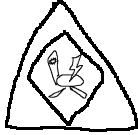 Crappy chair inside diamond inside triangle: Someone will send you info about a funder who funds equipment.
Crappy chair inside diamond inside triangle: Someone will send you info about a funder who funds equipment.
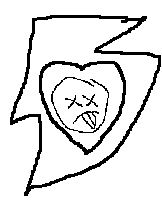 Passed-out face inside heart inside lightning bolt: Brilliant idea! Get a client to join the special event committee!
Passed-out face inside heart inside lightning bolt: Brilliant idea! Get a client to join the special event committee!
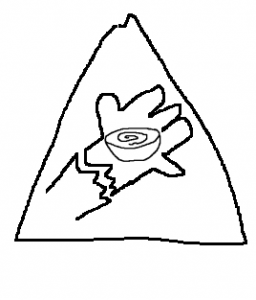 Hummus inside carpal tunnel inside triangle: Jim is supposed to get hummus for the board meeting but he has carpel tunnel and won’t make it, so John reluctantly agrees to do it.
Hummus inside carpal tunnel inside triangle: Jim is supposed to get hummus for the board meeting but he has carpel tunnel and won’t make it, so John reluctantly agrees to do it.
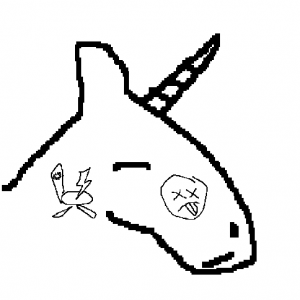 Crappy chair and passed-out face inside exhausted unicorn: Schedule mediation meeting between two staff on the annual event committee who are fighting over whose chair is crappier.
Crappy chair and passed-out face inside exhausted unicorn: Schedule mediation meeting between two staff on the annual event committee who are fighting over whose chair is crappier.
Prioritization:
With so much going on, it is important to figure out which items to tackle when. Which is why having different symbols for different things is helpful when you return from meetings and need to take care of all these action items. Depending on your role at your organization, you may prioritize differently. In general, I try to tackle things in this order:
Anything with a heart, followed by anything with a star, followed by anything with a diamond. When those are all checked off, I tackle all the squares, then the triangles (checking in to make sure people are actually doing stuff they committed to), then the hummus, then the lightning bolts. Exhausted unicorn symbols are also high-priority.
I hope this has been helpful. Remember even as you implement this system that there is no way to finish everything every week. To try to do so is to foster burnout. Figure out the 3 to 5 critical items you need to complete each day. For me, as an ED, they tend to be diamond shaped.
But not today. I need to clean out my fridge. The molds are developing advanced technologies. Are those…tiny spaceships on that hummus…?
—
Make Mondays suck a little less. Get a notice each Monday morning when a new post arrives. Subscribe to NWB by scrolling to the top right of this page and enter in your email address.
Discover more from Nonprofit AF
Subscribe to get the latest posts sent to your email.

